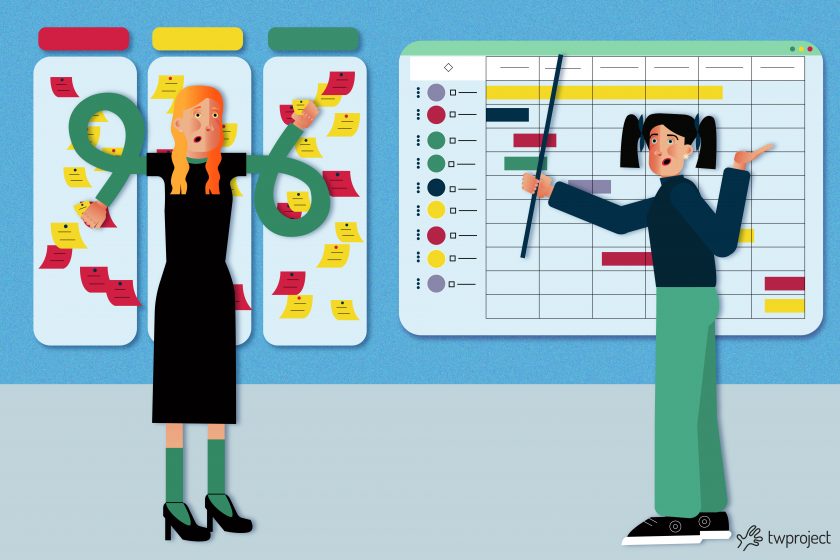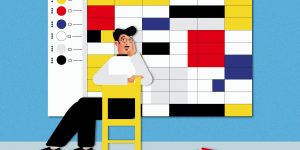Kanban vs. Gantt are two popular tools in project management that can significantly improve efficiency and effectiveness.
Both are valuable in different ways and have pros and cons.
In this article, we will compare their features and uses.
CONTENT
What is a Gantt chart?
A Gantt chart provides a clear overview of project progress.
Project managers can break down complex projects into smaller, more manageable tasks through this tool.
The chart visualizes each task as a horizontal bar, with its length representing the duration required for completion.
Arrows symbolize dependencies between activities and show the order in which they are to be completed.
Resource allocation can also be displayed in the Gantt chart.
By assigning resources to specific tasks, project managers can, therefore, ensure that the right people are working on the right activities at the right time.
Here is a list to provide a clearer understanding of the benefits and limitations of Gantt charts:
Pros of the Gantt chart
- Identifies activity dependencies;
- Visualize project schedule;
- Shows milestones (the critical path);
- Helps manage resource allocation;
- Indicates deadlines for activities;
- It helps break down the project into smaller, simpler tasks;
- Monitor progress.
Cons of the Gantt chart
- Its set-up can be complicated;
- It can be confusing;
- It does not state priorities;
- It includes more details than necessary for some team members;
- It requires time for adjustment;
- It is not recommended for projects lacking a clear end goal.
What is a Kanban board?
A Kanban board is a visual tool for the project manager and team to manage and monitor workflow.
The Kanban method, which is derived from the Lean methodology, is commonly used in agile processes.
The principle behind Kanban involves focusing on completing tasks before starting new ones.
Kanban means “signboard” in Japanese, and from this, we can see why each activity is represented by a “card” that moves across the board as it progresses through the different stages of the workflow.
Columns on the board usually include stages such as “To Do,” “In Progress,” and “End.” One of the main benefits of using Kanban boards is their visual nature, which provides a quick and user-friendly way to understand the status of tasks and the overall workflow.
Team members can easily see which activities are ongoing, which have been completed, and which have yet to be started.
Just like Gantt charts are useful for some things and not as useful for others, so are Kanban boards.
Here are the pros and cons of this methodology:
Pros of Kanban board
- Shows workflow;
- Boosts productivity;
- Reduces waste;
- Promotes collaboration;
- Provides flexibility;
- Prevents activity overload;
- User-friendly.
Cons of Kanban board
- It is difficult to determine when tasks will be completed;
- It can become too complex and inefficient;
- Must be constantly updated;
- Not suitable for projects with tight deadlines;
- Requires process stability;
- It does not show how long an activity has been on the board.
Gantt vs. Kanban: Which one should you use?
Kanban boards and Gantt charts are project management tools that visualize upcoming tasks, when they are to be completed, completion percentage, and, often, who is in charge of the tasks.
The main difference is that the Gantt chart shows the entire project on a visual timeline that also displays relationships between tasks. In contrast, the Kanban board focuses on the volume of work that needs to be done, is in progress, or is completed.
Therefore, the Gantt chart is better suited for planning since it can link dependencies and show the critical path, as well as resources, costs, and more. Kanban boards, on the other hand, are better for the team as it executes its tasks.
Team members can see what has been assigned and move it from one column to the next as they work on the task to completion.
Gantt vs Kanban: Why not use both with Twproject?
As this article has shown, the Gantt chart is better suited to a predictive approach, while the Kanban methodology is agile.
Nevertheless, you can use both, such as creating a Gantt chart for the project as a whole and applying the Kanban methodology to its subsets.
It might seem cumbersome to successfully integrate two tools during project management, but this and more becomes feasible thanks to project management software such as Twproject.
With Twproject, you can easily create Gantt charts and Kanban sheets and use other project visualizations.
This software is highly flexible and can adapt to any methodology.
Every company has its unique way of working, and Twproject was created to streamline processes while respecting the uniqueness of each reality.Gantt, Kanban, and more: Twproject cares about your success.


